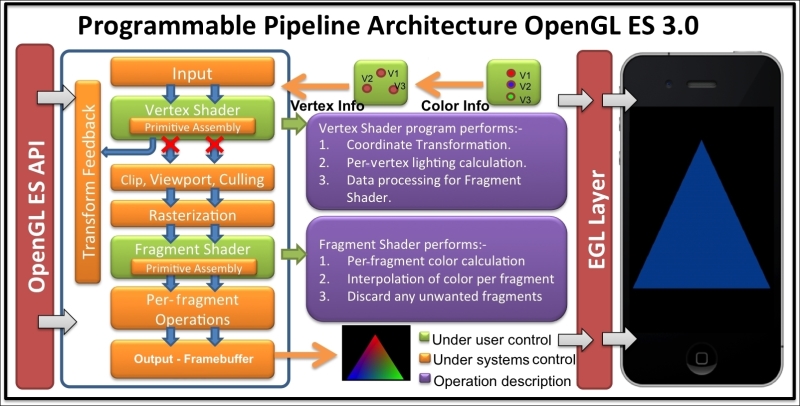OpenGL ES 3.0 stands for Open Graphics Library for embedded systems version 3.0. It is a set of standard API specifications established by the Khronos Group. The Khronos Group is an association of members and organizations that are focused on producing open standards for royalty-free APIs. OpenGL ES 3.0 specifications were publicly released in August 2012. These specifications are backward compatible with OpenGL ES 2.0, which is a well-known de facto standard for embedded systems to render 2D and 3D graphics. Embedded operating systems such as Android, iOS, BlackBerry, Bada, Windows, and many others support OpenGL ES.
OpenGL ES 3D APIs are the stripped-down version of OpenGL, which is a cross-platform standard 3D API on a desktop environment for Linux, various flavors of UNIX, Mac OS, and Windows. This stripped-down version is mainly focused on providing the capabilities of 3D graphics as per embedded system requirements such as low-power consumption, limited processing capabilities, and small memory footprints.
The OpenGL ES 2.0/3.0 graphics library is shading-language compliant, unlike its predecessor 1.1. The major difference between OpenGL ES 1.1 and OpenGL ES 2.0/3.0 is the graphics pipeline architecture. The graphics pipeline framework for the former is known as a fixed function pipeline, and for the latter, it is a programmable pipeline. These frameworks are explained in the following table:
|
OpenGL ES version |
Architecture pipeline type |
Need shader |
|---|---|---|
|
1.1 |
Fixed function pipeline |
No |
|
2.0 and 3.0 |
Programmable pipeline |
Yes |
A pipeline is a set of events that occur in a predefined fixed sequence, from the moment input data is given to the graphic engine to the output generated data for rendering the frame. A frame refers to an image produced as an output on the screen by the graphics engine.
Each frame in a fixed function pipeline architecture is generated by a fixed set of algorithms, calculations, and sequences of events. You can only specify what you want, but not how it will be calculated. For example, if you are interested in applying some light shading on your solid sphere model, then you will need to specify the light position, its intensity, material properties, and other similar attributes. The fixed pipeline uses these inputs and takes care of all the physics and mathematics required to generate the light shading. Therefore, you don't need to worry, as the how factor is fully abstracted. The good side of the fixed function pipeline is that it is very easy to understand and quick to program.
In contrast, with the programmable pipeline architecture, you not only need to specify what you want to achieve, but you also need to mention how to implement it. This pipeline also provides extraordinary capabilities through shaders. Shaders are the special programs that control your scene's geometry and shading appearance. For example, in order to achieve the same light-shading effect on solid sphere, you must know the basics of physics and mathematics in order to program the light-shading techniques. Since you are programming the behavior of light shading, you can fully control it. This opens up endless possibilities to create infinite shading effects. Shaders are super fast. They execute rendering in parallel-processing mode using Graphics Processing Unit (GPU).
Now, the question is if fixed function pipeline is doing all the light physics and mathematical abstraction, then why do we need to understand it for programmable pipelines? The reason is with fixed pipeline, we can only do finite graphics capabilities, and it cannot be used to produce realistic graphics effectively. However, the programmable pipeline opens endless possibilities and opportunities to produce state-of-art graphics rendering.
This chapter will provide OpenGL ES 3.0 development on Android and iOS. We will begin this chapter by understanding the basic programming of the OpenGL ES 3.0 with the help of a simple example to render a triangle on the screen. You will learn how to set up and create your first application on both platforms step by step.
Understanding EGL: The OpenGL ES APIs require the EGL as a prerequisite before they can effectively be used on the hardware devices. The EGL provides an interface between the OpenGL ES APIs and the underlying native windowing system. Different OS vendors have their own ways to manage the creation of drawing surfaces, communication with hardware devices, and other configurations to manage the rendering context. EGL provides an abstraction, how the underlying system needs to be implemented in a platform-independent way. The platform vendor's SDK provides an implementation of EGL through their own framework. These can be directly used in the application to accomplish the development task quickly. For example, the iOS provides EGL through the EAGL (EAGLContext) class in conjunction with GLkit to create GLSurface. On the Android platform, the GLView class provides interfaces for EGL through GLView.EGLContextFactory and GLView.EGLConfigChooser.
The EGL provides two important things to OpenGL ES APIs:
Rendering context: This stores the data structure and important OpenGL ES states that are essentially required for rendering purpose
Drawing surface: This provides the drawing surface to render primitives
The following screenshot shows the programmable pipeline architecture of OpenGL ES 3.0:

EGL works on top of the native windowing system, such as WGL (Windows), GLX, or X-Windows (Linux), or Mac OS X's Quartz. With EGL specifications, cross-platform development becomes easier.
EGL provides the following responsibilities:
Checking the available configuration to create rendering context of the device windowing system
Creating the OpenGL rendering surface for drawing
Compatibility and interfacing with other graphics APIs such as OpenVG, OpenAL, and so on
Managing resources such as texture mapping
Note
You can refer to the following link for more information on EGL http://www.khronos.org/egl.



